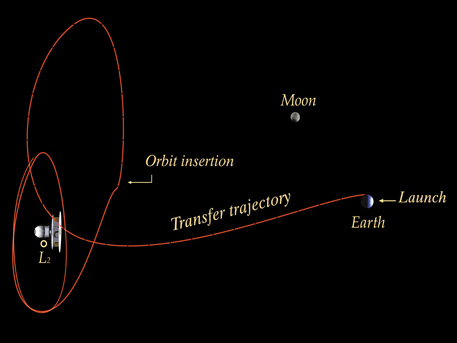Planck reaches orbit around L2
Coolest spacecraft ever in orbit
 © ESA |
Planck's orbit around L2, the second Lagrange point of the Sun-Earth system.
Such low temperatures are necessary for Planck’s detectors to study the Cosmic Microwave Background (CMB), the first light released by the universe only 380 000 yrs after the Big Bang, by measuring its temperature across the sky.
The detectors will look for variations in the temperature of the CMB that are about a million times smaller than one degree – this is comparable to measuring from Earth the heat produced by a rabbit sitting on the Moon. This is why the detectors must be cooled to temperatures close to absolute zero (–273.15°C, or zero Kelvin, 0K).
A maneuver earlier this week directed the satellite into its final operational orbit around the second Lagrange point of the Sun-Earth system, L2.
The manoeuvre was planned to change the satellite’s speed by 211.6 km/hour, ending with a final speed of 1010 Km/hour with respect to the ground. Together with Earth and the virtual point L2, Planck will then be orbiting the Sun at a speed of 106 254 km/hour (29.5 km/second).
Science operations to begin soon
All commissioning activities are on schedule, and this phase of the mission is practically complete. Over the next few weeks, the operation of the instruments will be fine-tuned for best performance.
The coolest space craft in the universe will begin to survey the sky in mid-August.
ESA
Planck reaches orbit around L2
Coolest spacecraft ever in orbit
 © ESA |
Planck's orbit around L2, the second Lagrange point of the Sun-Earth system.
Such low temperatures are necessary for Planck’s detectors to study the Cosmic Microwave Background (CMB), the first light released by the universe only 380 000 yrs after the Big Bang, by measuring its temperature across the sky.
The detectors will look for variations in the temperature of the CMB that are about a million times smaller than one degree – this is comparable to measuring from Earth the heat produced by a rabbit sitting on the Moon. This is why the detectors must be cooled to temperatures close to absolute zero (–273.15°C, or zero Kelvin, 0K).
A maneuver earlier this week directed the satellite into its final operational orbit around the second Lagrange point of the Sun-Earth system, L2.
The manoeuvre was planned to change the satellite’s speed by 211.6 km/hour, ending with a final speed of 1010 Km/hour with respect to the ground. Together with Earth and the virtual point L2, Planck will then be orbiting the Sun at a speed of 106 254 km/hour (29.5 km/second).
Science operations to begin soon
All commissioning activities are on schedule, and this phase of the mission is practically complete. Over the next few weeks, the operation of the instruments will be fine-tuned for best performance.
The coolest space craft in the universe will begin to survey the sky in mid-August.
ESA





